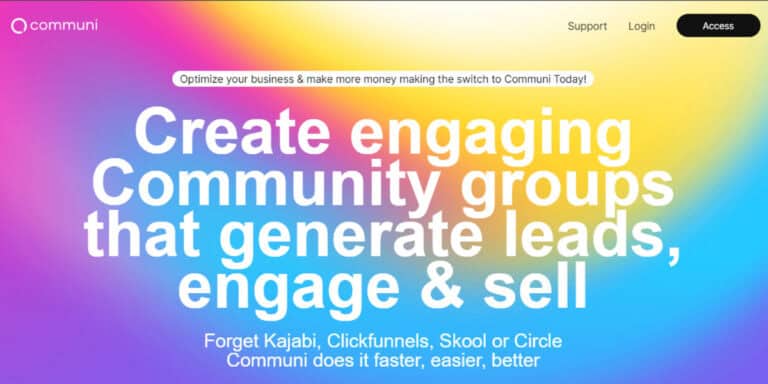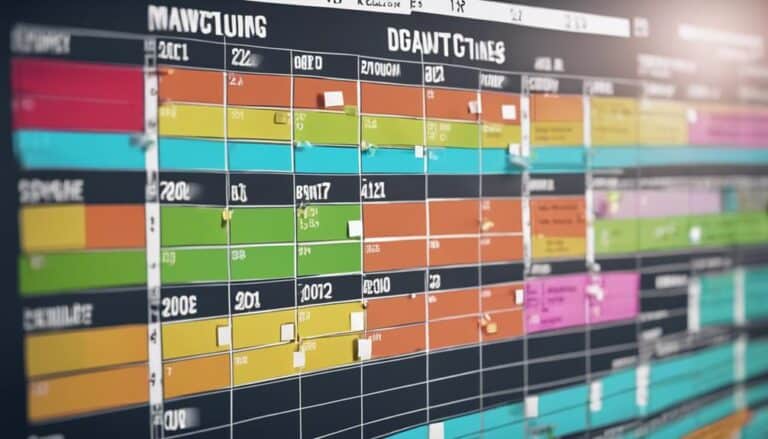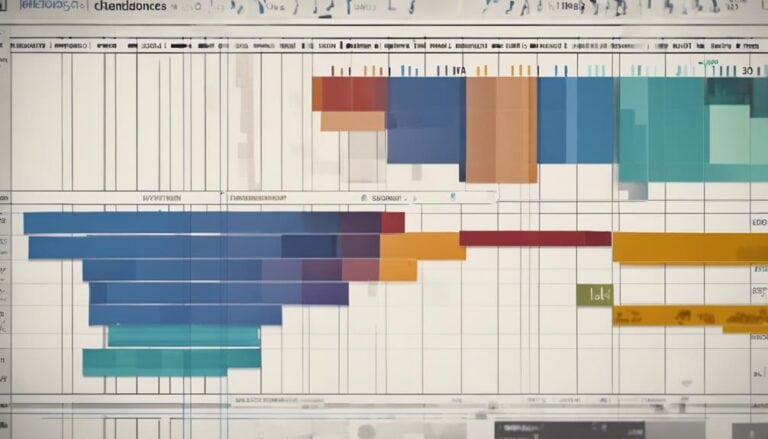Unlock the potential of your projects with the precision and power of Gantt charts.
Navigating the intricate web of project management can be daunting, but fear not – this expert guide will illuminate the path to success.
From unraveling the mysteries of task dependencies to harnessing the true potential of timelines, this guide is your compass in the vast sea of project planning.
Explore the depths of Gantt chart mastery and chart your course to project triumph.
Key Takeaways
- Define project scope and objectives clearly
- Choose the right tool for comprehensive features
- Set up a detailed project timeline with dependencies
- Enhance project management efficiency and collaboration
Importance of Gantt Charts
Utilizing Gantt charts enhances project management efficiency by visually mapping out timelines, tasks, and milestones. Gantt charts provide a structured way to organize and manage projects effectively. They enable you to break down a project into tasks, assign responsibilities, and set realistic timelines for each activity. By using Gantt charts, you can track progress, identify potential bottlenecks, and make necessary adjustments to ensure project success.
One key benefit of Gantt charts is their ability to help in managing project milestones. These visual representations allow you to see critical points in the project timeline, ensuring that important deadlines are met. Additionally, Gantt charts promote team collaboration by providing a clear overview of who's responsible for each task and how tasks are interconnected. This fosters communication among team members, enhances accountability, and promotes a sense of ownership over project outcomes.
Furthermore, Gantt charts aid in resource management by allowing you to allocate resources efficiently based on the project timeline. By visually representing resource allocation alongside tasks and deadlines, you can ensure that resources are utilized effectively throughout the project lifecycle.
Key Components of Gantt Charts
Gantt charts, essential tools in project management, comprise key components that facilitate effective planning and execution. When creating a Gantt chart, it's crucial to include the following components:
- Tasks displayed as horizontal bars: Each task is represented by a horizontal bar, with the length indicating the duration of the task.
- Milestones marked by diamond symbols: Key project achievements are denoted by diamond symbols to highlight significant progress points.
- Dependencies shown through connecting lines: Task relationships and dependencies are illustrated by connecting lines between related tasks.
- Project timeline for visualization: The horizontal axis on the Gantt chart represents the project timeline, allowing for clear visualization and timeline management.
Preparing for Gantt Chart Creation
Before diving into creating your Gantt chart, ensure you define the project scope and identify key tasks. This initial step lays the foundation for a well-structured chart that accurately represents your project plan.
Define Project Scope
To prepare for creating a Gantt chart, start by clearly defining the project scope, which involves outlining the goals, objectives, deliverables, and constraints of the project. When defining the project scope, ensure to:
- Identify project boundaries for a clear understanding.
- Outline objectives and deliverables to set project expectations.
- Define stakeholders involved to manage communication effectively.
- Establish constraints to understand project limitations.
A detailed scope definition not only helps in setting clear project boundaries but also aids in avoiding scope creep. Understanding the project scope is crucial for accurate task identification, timeline estimation, and ultimately creating a comprehensive Gantt chart that aligns with the project objectives.
Identify Key Tasks
Identifying key tasks is essential for laying a solid foundation in the preparation process for creating a Gantt chart. Begin by listing all necessary task names to ensure comprehensive project coverage.
Estimate the duration each task will take to complete accurately. This information will help you schedule tasks effectively on the Gantt chart using bars to represent the timeline.
Identifying dependencies is crucial; these indicate the order in which tasks should be completed. Recognizing potential dependencies allows you to stay organized and enhance your project planning.
A clear and comprehensive list of key tasks will ultimately lead to a well-structured Gantt chart, aiding in successful project execution.
Choosing the Right Tool
When selecting the right tool for your Gantt chart needs, prioritize compatibility with your existing project management software to ensure seamless integration. To make the best choice, consider the following:
- Scalability: Ensure the tool can grow with your projects, accommodating increased complexity and size.
- Comprehensive Features: Look for capabilities such as task dependencies, progress tracking, and resource allocation for effective project management.
- Customizable Options: Opt for tools with user-friendly interfaces and customizable features to tailor the tool to your specific project requirements.
- User Feedback: Explore customer reviews and testimonials to assess the tool's reliability, support, and overall user satisfaction levels.
Setting Up Project Timeline
Make sure your project timeline is solid from the get-go by clearly defining key tasks, milestones, and external factors that may impact your project's progress.
Begin by establishing the project start and end dates to provide a framework for your timeline. Identify key tasks that need to be accomplished and set milestones to track your progress effectively.
Consider external factors such as holidays or resource availability that could influence your timeline. Determine task dependencies to ensure that activities are sequenced correctly for a smooth flow of work.
Allocate appropriate time frames for each task based on their complexity and requirements to create a realistic and achievable project timeline.
Incorporating Task Details and Dependencies
To enhance project planning accuracy and facilitate effective task management, ensure that your Gantt chart incorporates detailed task information and dependencies. Here's how you can do it:
- Task Details: Include task names, start and end dates, duration, and assigned resources for clarity in understanding the scope of individual tasks.
- Dependencies: Clearly depict task relationships and sequencing to show the order in which tasks must be completed.
- Sequencing: Ensure tasks are sequenced correctly to prevent delays from impacting the entire project timeline.
- Project Planning: Incorporating task details and dependencies in your Gantt chart will enhance project planning accuracy, making it easier to manage tasks effectively within the project framework. By paying attention to these aspects, you can create a Gantt chart that serves as a reliable guide for successful project execution.
Frequently Asked Questions
How Do You Make a Successful Gantt Chart?
To make a successful Gantt chart, ensure task dependencies are clear, allocate resources efficiently, identify the critical path, visualize timelines effectively, mark project milestones, collaborate with the team, track progress, manage risks, handle time wisely, and plan communication.
What Are the 7 Important Elements of a Gantt Chart?
To create a successful Gantt chart, include task dependencies, resource allocation, time management, milestone tracking, critical path identification, progress monitoring, project visualization, team collaboration, project scheduling, and data analysis. These elements ensure effective project planning and execution.
What Are the 4 Components of a Gantt Chart?
In a Gantt chart, task dependencies, resource allocation, time management, and project milestones are crucial components. Understanding the critical path, task duration, progress tracking, task assignment, sequencing, and deadline management ensures effective project planning and execution.
How a Gantt Chart Can Be Used to Evaluate Progress of a Project?
Track progress, complete tasks, analyze timelines, allocate resources, track milestones, collaborate with the team, evaluate projects, measure performance, manage task dependencies, and plan projects effectively using a Gantt chart. It's your project success tool.
Conclusion
Now that you have mastered the art of Gantt charts, you're ready to tackle any project with confidence and efficiency.
Remember, proper planning leads to project success.
So, go ahead, create timelines, assign tasks, and monitor progress like a pro.
With your newfound knowledge and tools, the sky's the limit for your project management success!





